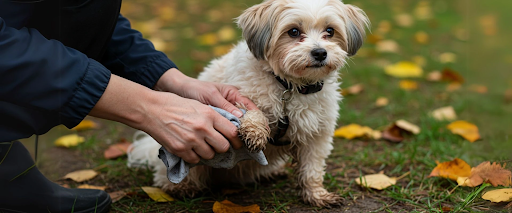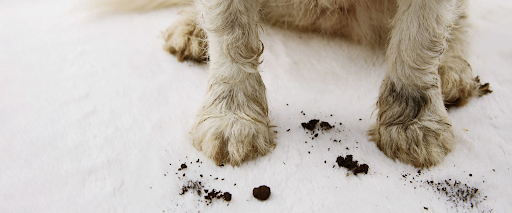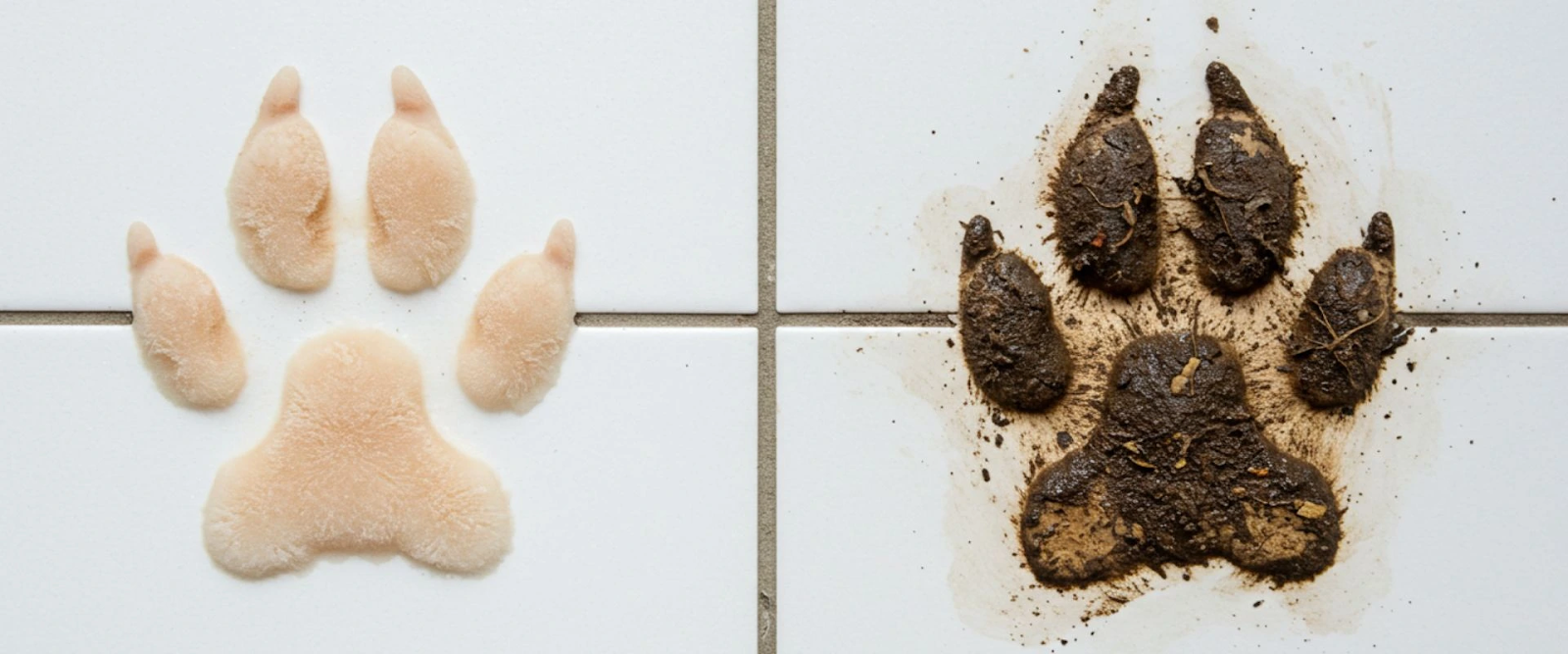How to Clean Dog Paws Safely After Walks
Keeping your dog's paws clean after walks isn’t just about tidiness; it’s essential for their health and happiness. Whether you've just strolled through a muddy park or crossed hot, grimy pavements, giving those paws some post-walk can prevent infections and injuries.If you’re looking for a convenient and professional solution, Boops N' Bubbles offers top-notch services right at your doorstep. Their experienced team specializes in gentle paw cleaning, ensuring your furry friend stays comfortable and stress-free throughout the process. With their mobile grooming service, you can easily maintain your pet’s cleanliness without the hassle of traveling to a grooming salon.
This guide will take you through how to clean dog paws step-by-step, why it matters, dog paw hygiene tips to make it part of your pet care routine and muddy dog paws cleaning routine.
Why Cleaning Dog Paws After Walks Matters
Your pup’s paws are exposed to all sorts of surfaces, and while they’re durable, they aren’t immune to problems. Dirt and debris can build up, leading to discomfort and even health risks. Here’s why regular dog paw cleaning or cleaning dog paws after walk is important:
- Prevents injuries. Removing sharp objects like thorns or pebbles reduces the risk of cuts or scrapes.
- Avoids infections. Clean dog paws are less likely to harbor bacteria, fungi, or harmful chemicals from pesticides or salt.
- Reduces allergens. Your dog may bring allergens like pollen indoors, which can affect sensitive family members.
- Protects furniture and floors. Clean dog paws mean less mud and dirt tracked into your home.

How to Clean Dog Paws After Walks
Follow these six simple steps how to clean dogs paws effectively without causing discomfort to your furry friend:
1. Check Their Paws for Debris or Injuries
Before cleaning paw, inspect each paw carefully:
- Look for small stones, thorns, or debris that might get lodged between the pads.
- Check for redness, swelling, or cuts.
- If you spot anything serious, it’s best to call your vet.
Pro Tip: Make it a habit to check your dog’s feet after every walk to catch potential issues early.
2. Prepare the Cleaning Area
Gather your supplies in one accessible spot to make the cleaning process quicker:
- A shallow bowl or gentle spray of lukewarm water.
- A mild dog-safe soap or shampoo.
- A soft, clean towel.
- Dog paw balm (optional, for extra hydration).
If you're short on time, pet-safe grooming wipes can also do the trick for light cleaning tasks.
3. Gently Wash Each Paw
Place one paw at a time into the water, ensuring you clean between the pads and around the nails. Mild soap is great for cutting grease or grime, but make sure to rinse thoroughly to avoid irritation.
4. Dry Properly
Pat each paw dry with a soft towel. Make sure there’s no moisture left between the pads or under the nails, as damp areas can lead to bacterial or fungal growth.
For long-haired breeds, you may need to trim excess fur around the paw pads for easier maintenance or book a professional grooming service for paw pad grooming including nail trimming or more for a healthy dog.
5. Apply Balms for Protection
Paw balms or moisturizers can help soothe dry, cracked pads, especially if your dog frequently walks on rough surfaces or cold, icy pavements.
Choose a product that’s pet-safe and free from toxic chemicals.
6. Treat and Reward
Make the process enjoyable by showering your pup with praise or offering their favorite treat after paw-cleaning time. Positive reinforcement helps them associate cleaning with a rewarding experience.
7. Trim Excess Hair Around the Paws
Long hair around your dog's paws can trap dirt, debris, and snow, making cleaning more difficult. Use pet-safe scissors or clippers to carefully trim the fur between and around the paw pads. This helps keep their paws clean and reduces the risk of matting or irritation.
8. Inspect for Injuries Regularly
While cleaning, take the opportunity to check for cuts, scrapes, or embedded objects like small stones or thorns. Early detection of injuries can prevent infection and ensure that your dog stays comfortable and active.
9. Keep Nails Trimmed
Overgrown nails can alter your dog’s gait and put added pressure on their paw pads, leading to discomfort or even injury. Regular nail trimming is essential for paw health and overall mobility.
10. Be Mindful of Weather Conditions
Extreme temperatures can harm your dog's paws. On hot days, pavement and sand can burn sensitive pads, while cold, icy surfaces can cause cracking or frostbite. Always assess ground conditions before your walk and consider using protective dog boots if necessary.

Dog Paw Hygiene Tips for Preventing Issues
Following are the essential dog paw hygiene tips to prevent issues like infections, cuts etc
- Wash Paws Regularly: After walks, gently wash your dog's paws with warm water to remove dirt, debris, or harmful substances like salt or chemicals.
- Dry Thoroughly: Always dry your dog's paws completely after washing or exposure to wet environments to prevent fungal or bacterial growth.
- Inspect for Injuries: Check your dog's paws routinely for cuts, cracks, or any foreign objects lodged between the pads.
- Moisturize When Needed: Use a pet-safe paw balm or moisturizer to prevent dryness and cracking, especially during harsh weather.
- Trim Fur Between Pads: If your dog has long fur, trim the hair between their paw pads to reduce matting and keep dirt from accumulating.
- Avoid Harmful Surfaces: Where possible, avoid walking your dog on sharp, rough, or abrasive surfaces that can cause damage to their paws.
- Trim paw fur regularly to avoid dirt entanglement and matting.
- Avoid harmful substances like road salts during winter or hot asphalt in summer, as they can harm your dog’s paws.
- Switch up your routes. Opt for grass or softer trails instead of rough, abrasive surfaces.
- Use dog booties or shoes for extreme weather conditions. They act as a barrier against snow, ice, or scorching hot pavement.

Dealing with Specific Challenges
Muddy Dog Paws Cleaning
Follow these steps for muddy dog paws cleaning
- Keep a towel or cleaning wipes by the door to quickly clean muddy dog paws after outdoor activities.
- Use lukewarm water and a gentle dog-safe cleanser to wash away stubborn mud.
- Dry your dog's paws thoroughly to prevent irritation or fungal infections caused by moisture.
- Check between the toes for small debris like pebbles or thorns that could cause discomfort.
- Consider setting up a shallow water basin near your entrance to rinse mud off before entering your home.
Salty or Chemical Surfaces
Ice-melting chemicals or salt used on roads and sidewalks can irritate your dog's paws, causing dryness, cracking, or even burns.
- After walks, thoroughly wipe their paws with a damp cloth to remove any residues.
- Consider using dog booties to protect paws from harmful substances and harsh surfaces.
- Wash paws with lukewarm water if exposure to chemicals or salt is unavoidable to prevent lingering irritation.
- Apply a paw balm afterward to soothe and moisturize the skin.
Allergy and Pollen Protection
Wipe your dog’s paws and coat with a damp cloth after walks to remove pollen and allergens.
- Bathe your dog regularly using a gentle, hypoallergenic shampoo to reduce allergen buildup.
- Brush your dog’s fur frequently during allergy season to remove loose hair and trapped pollen.
- Limit outdoor exposure during peak pollen times, typically early morning and late evening.
- Create a designated indoor play area for exercise on high-pollen days.
- Consult with a professional groomer if your dog shows severe allergy symptoms, such as excessive scratching or redness.
When to Seek Professional Help
Notice something unusual during your paw inspections? A professional groomer or vet can help:
- Persistent irritation or redness.
- Visible swelling or limping after a walk.
- Excessive licking or biting at the paws.
A mobile dog grooming service, specializes in paw care and more. Offering cage-free, one-on-one attention, they provide a comfortable, stress-free environment for your pup. Whether your dog needs a nail trim, paw pad cleaning, or a full grooming service, their expert team will leave your furry friend feeling their absolute best.
With locations in Alamo, Blackhawk, Danville, Diablo, Dublin, San Ramon, and Pleasanton, Boops N' Bubbles offers a flexible and convenient solution for pet owners in the East Bay.
FAQs About Dog Paw Care
1. How often should I clean my dog’s paws?
Ideally, after every walk. This keeps dirt, allergens, and harmful substances away and ensures your house stays clean too.
2. What’s the best way to clean muddy dog paws?
Use lukewarm water and a soft-bristled brush to remove stubborn dirt, especially in between the pads. Finish by drying thoroughly.
3. Can I use baby wipes to clean my dog’s paws?
Baby wipes are not recommended, as they may contain ingredients that are too harsh for your dog’s skin. Opt for pet-safe grooming wipes instead.
4. What if my dog hates having their paws touched?
Start slow. Ease your dog into the process by gently handling their paws during bonding time, rewarding them with treats to build trust.
5. Do I need to moisturize my dog’s paws?
Yes, if your dog’s paw pads appear dry or cracked. Use a pet-safe balm to keep them soft and hydrated.


